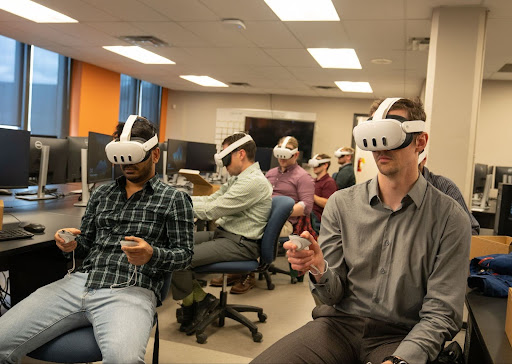The Saskatchewan minerals industry is a huge provincial, national and global asset, supplying over 11,000 jobs in Saskatchewan while providing essential and critical minerals to the world. Mining, quarrying and oil and gas extraction is the largest sector in Saskatchewan, accounting for 26.62% of the province’s gross domestic product (GDP).
In addition, it’s an economically competitive industry. According to the Government of Saskatchewan, in December 2024, the value of Saskatchewan’s total mineral sales increased by $1.0B, up 11.9% from December 2023.
As mining is a true foundation for our province, we are committed to constant improvement and innovation that increases sustainability, efficiency, and safety. This starts with training our upcoming workforce to be adaptable and lifelong learners.
We see an impressive affinity for innovation in the industry, especially when workers and students are provided with everything they need to excel. From new pathways to specialization to hands-on learning, the minerals industry is dedicated to educating a strong workforce.
The Role of Education in Advancing Saskatchewan’s Minerals Industry
1. Adapting Education to Industry Needs
As the mining industry evolves, education and training must keep pace with technological advancements and industry changes. New systems, technologies, and processes are constantly adopted on mine sites, so educational institutions must stay updated and reactive in their curriculums to follow suit.
IMII works hard to foster innovation, sustainability and workforce readiness through partnerships with our industry and education members. When industry and education collaborate, barriers are broken down, and progress can truly be made.
You can learn more about our completed Workforce Development projects here! Check out highlights like:
2. Meeting Demand for Specialized Skills
The demand for specialized skills continues to grow as the minerals sector incorporates more advanced technology, automation and digital solutions. Post-secondary institutions must provide students with the technical knowledge, problem-solving abilities, and hands-on experience to thrive in these rapidly changing fields.
The mining sector has many areas of specialization and expertise that keep things running smoothly. To name a few:
- Geosciences (geological technologists and technicians, geotechnical engineering)
- Advanced technologies (digital mining, automation, data analytics)
- Engineering (civil, mining, mechanical)
- Natural resources managers (environmental management)
Each of these specializations experiences changes and improvements as research into sustainability, technology, efficiency, and safety progresses. Students interested in mining careers get to explore their passions and interests within the sector through education. Tailored educational experiences are necessary to develop a strong, talented, skilled workforce.
Post-Secondary Programs Directly Linked to Mining
In response to the ongoing specialization of the mining industry, educational institutions have followed suit. Students can choose from various mining educational pathways, including mining engineering, geotechnical engineering, and environmental management, to support the industry’s success.
At the University of Saskatchewan, students have their pick of various mining pathways, including geological engineering, civil engineering, environmental engineering, or a mining option within mechanical engineering.
Saskatchewan Polytechnic offers a mining engineering technology diploma through the Nutrien School of Mining, Manufacturing and Engineering Technologies.
Hands-On Training for the Minerals Industry
Some things can’t be taught in the classroom. Theoretical learning is an important part of all programs, but having real-world experiences is deeply important for the quality of education for mining students.
IMII supports hands-on training and work-integrated learning (WIL) opportunities, connecting students with industry through internships, co-op programs, and field projects. The chance to try safety procedures, train on new technologies, and go through processes is invaluable.
Some top-tier examples of WIL here in Saskatchewan include:
- Saskatchewan Polytechnic’s Mining Engineering Technology and Geotechnical Engineering programs offer work placements with industry partners. In addition, Sask Polytech is home to a state-of-the-art virtual reality mine lab that enhances students’ learning experience and prepares them for the realities of their careers. Learn more in this article.
- The University of Saskatchewan’s College of Engineering provides mining engineering students with practical field experience and involvement in industry-related research projects.
- The University of Regina has a strong co-op placement program.
- Morris Interactive’s Digital Transformation in Potash program offers Indigenous students the chance to gain hands-on mining experience. Read more about the program in this blog!
Preparing the Next Generation of the Mining Workforce
IMII is driving innovative opportunities and solutions, creating pathways from education to employment through strategic collaborations and workforce development initiatives.
Here’s how some of our industry and education members are contributing to change the face of mining education for the better:
- The BHP Potash Academy, piloted by Carlton Trail College in Humboldt, SK. The first cohort of this 8-month paid program began in January. They will experience a combination of classroom and on-site learning to shape strong maintenance and production employees for BHP’s Jansen mine site.
- Cameco prioritizes on-the-job training, offering apprenticeships, internships and skilled trades training programs. Through their apprenticeship programs, apprentices complete technical and on-the-job training for up to four years. Internships are offered for summer students, co-op students/interns, and new grades.
- Saskatchewan Polytechnic offers a digital upskilling for the mining sector program, designed to support those working in mining or interested in working in mining as they upgrade their skills.
- The Saskatchewan Indian Institute of Technologies (SIIT) Mining Industry Pre-Employment Program (MIP) is designed to equip students with the skills they need to thrive in the minerals industry.
By investing in strong mining education, we can impact the long-term success of the minerals industry while providing opportunities for individuals to have fulfilling careers. Workers who are innovative and adaptive will continue to change the industry for the better by improving sustainability, efficiency, safety and more.
Saskatchewan is known for its hardworking people, and you’ll find many of them in the minerals industry. We look forward to a long future of supporting mining education and the health of our minerals industry. Stay updated on our activities here!



